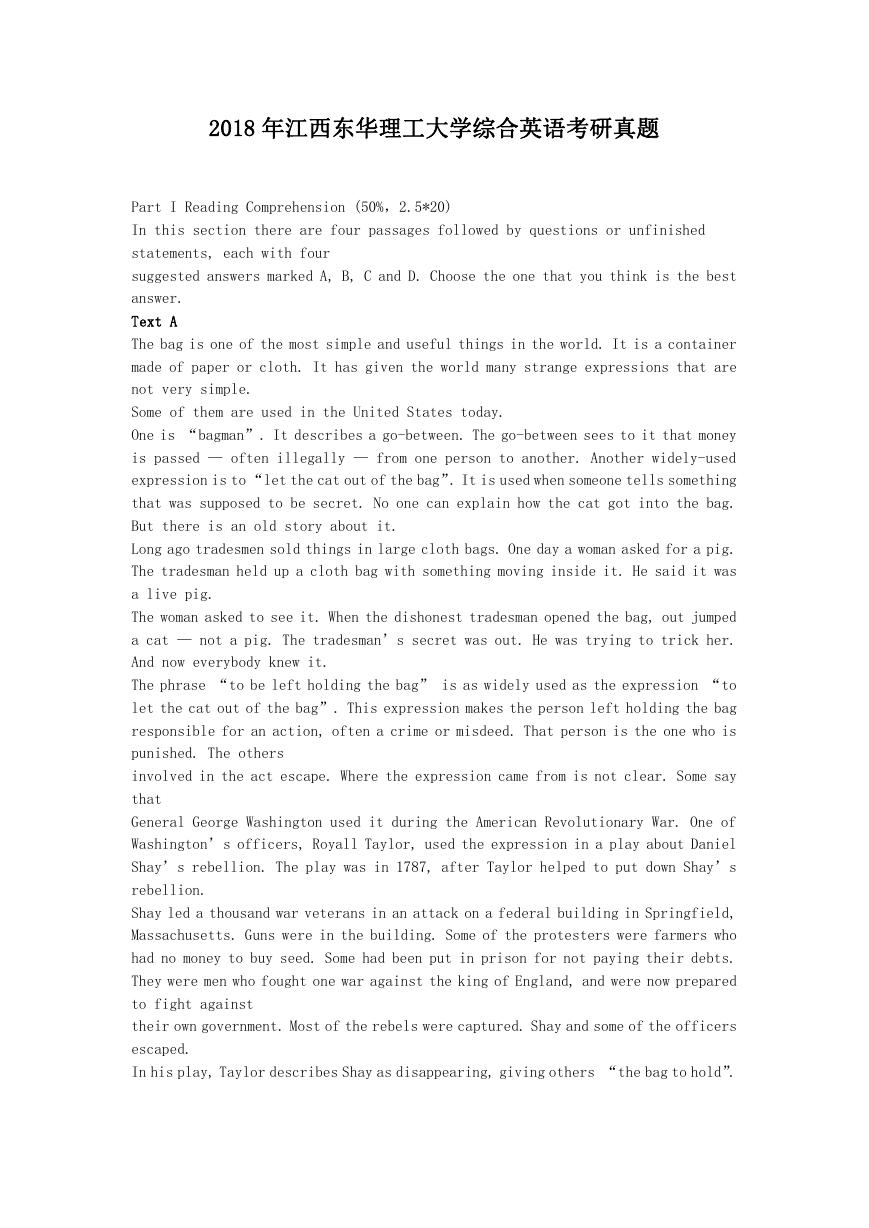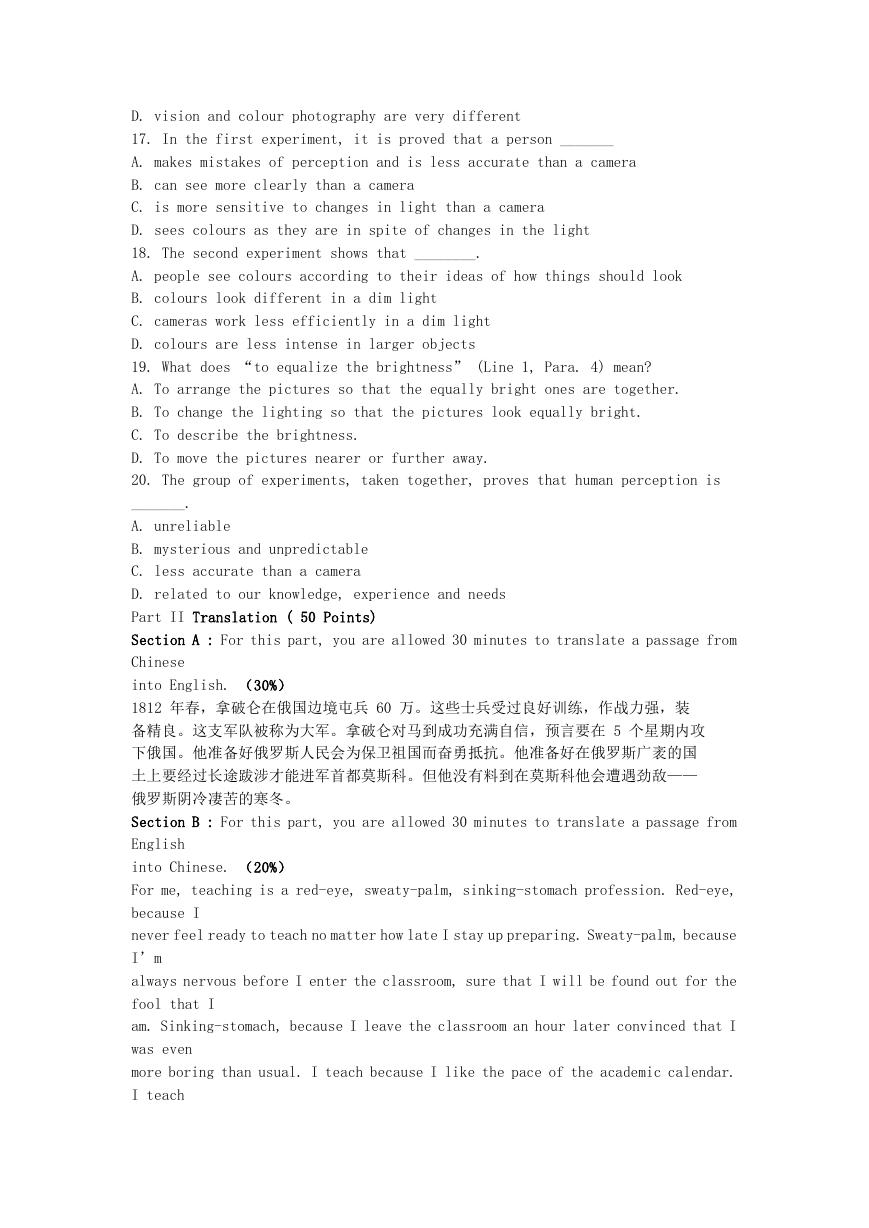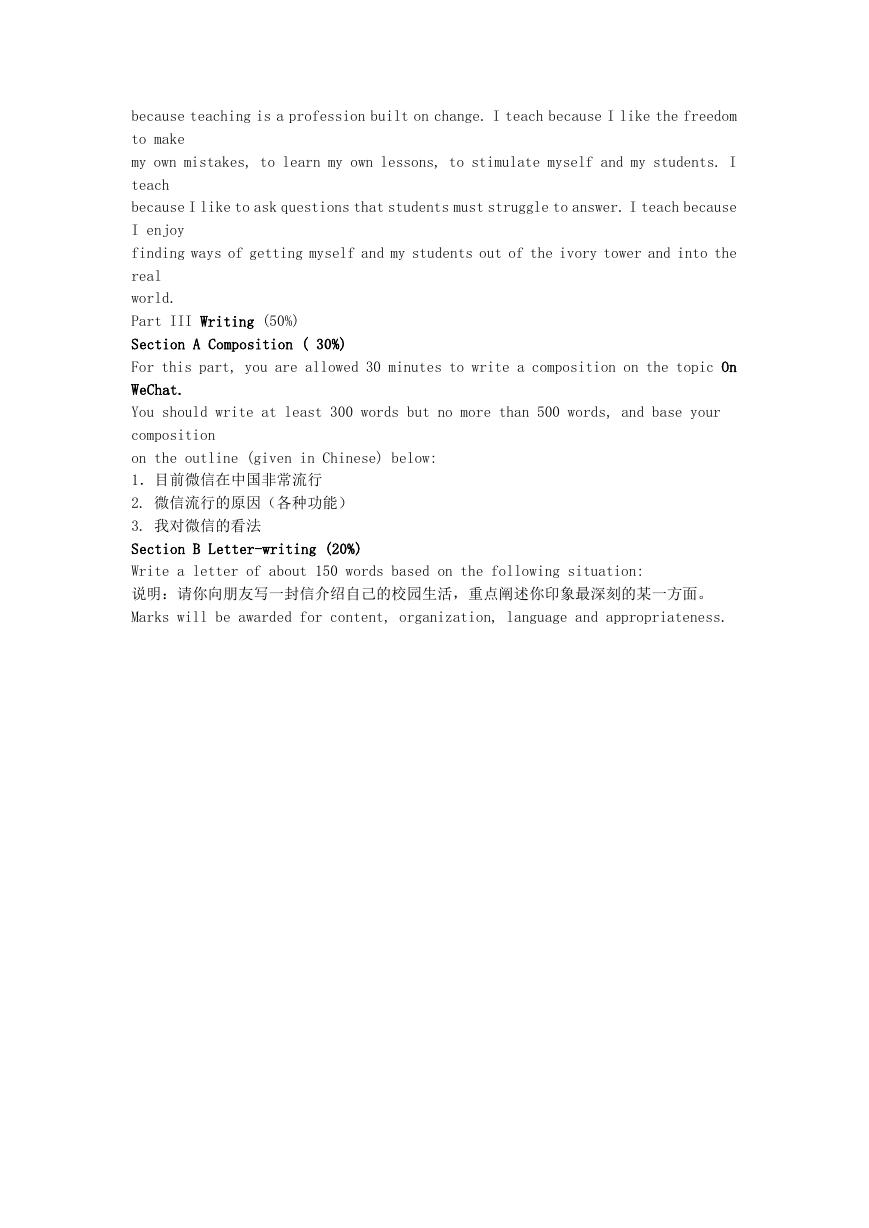2018 年江西东华理工大学综合英语考研真题
Part I Reading Comprehension (50%,2.5*20)
In this section there are four passages followed by questions or unfinished
statements, each with four
suggested answers marked A, B, C and D. Choose the one that you think is the best
answer.
Text A
The bag is one of the most simple and useful things in the world. It is a container
made of paper or cloth. It has given the world many strange expressions that are
not very simple.
Some of them are used in the United States today.
One is “bagman”. It describes a go-between. The go-between sees to it that money
is passed — often illegally — from one person to another. Another widely-used
expression is to “let the cat out of the bag”. It is used when someone tells something
that was supposed to be secret. No one can explain how the cat got into the bag.
But there is an old story about it.
Long ago tradesmen sold things in large cloth bags. One day a woman asked for a pig.
The tradesman held up a cloth bag with something moving inside it. He said it was
a live pig.
The woman asked to see it. When the dishonest tradesman opened the bag, out jumped
a cat — not a pig. The tradesman’s secret was out. He was trying to trick her.
And now everybody knew it.
The phrase “to be left holding the bag” is as widely used as the expression “to
let the cat out of the bag”. This expression makes the person left holding the bag
responsible for an action, often a crime or misdeed. That person is the one who is
punished. The others
involved in the act escape. Where the expression came from is not clear. Some say
that
General George Washington used it during the American Revolutionary War. One of
Washington’s officers, Royall Taylor, used the expression in a play about Daniel
Shay’s rebellion. The play was in 1787, after Taylor helped to put down Shay’s
rebellion.
Shay led a thousand war veterans in an attack on a federal building in Springfield,
Massachusetts. Guns were in the building. Some of the protesters were farmers who
had no money to buy seed. Some had been put in prison for not paying their debts.
They were men who fought one war against the king of England, and were now prepared
to fight against
their own government. Most of the rebels were captured. Shay and some of the officers
escaped.
In his play, Taylor describes Shay as disappearing, giving others “the bag to hold”.
�
A bag is useful in many ways. Just be careful not “to let the cat out of the bag”,
or someone may leave you “holding the bag”.
1. According to the passage, a bagman refers to _________________.
A) a person who travels around carrying his things in a bag B) a vagrant worker
C) a person who delivers or collects money for criminals
D) a homeless person
2. Which of the following is TRUE concerning the story about “let the cat out of
the bag”?
A) The tradesman wanted to play a joke with the woman.
B) The woman wanted to buy a cat.
C) The tradesman kept a cat in a plastic bag.
D) The tradesman lied to the woman that he had a live pig in the bag.
3. What can we infer from the story “to be left holding the bag”?
A) The person left holding the bag was completely innocent.
B) The person left holding the bag took no responsibility for committing crimes.
C) Many farmers protested against the government because they couldn’t pay their
debts.
D) Many protesters became the scapegoats for Shay and his officers.
4. What does the last sentence of this passage mean?
A) A bag has many different functions.
B) People should often keep secret or they will be left to take the responsibility
for everything.
C) People should watch out and learn to take the responsibility for their actions.
D) You will have to hold the bag if you let the cat out of it.
5. The best title for this passage is ________________.
A) Don’t Let the Cat Out of the Bag
B) To Be Left Holding a Bag
C) Words and Their Stories: Bag Expressions
D) Bag: A Useful Container
Text B
Traditional plant breeding involves crossing varieties of the same species in ways
they could cross naturally.For example,disease-resistant varieties of wheat have
been crossed with high-yield wheat to combine these properties.This type of natural
gene exchange is safe and fairly predictable.
Genetic engineering(GE)involves exchanging genes between unrelated species that
cannot naturally exchange genes with each other.GE can involve the exchange of genes
between vastly different species—e.g. putting scorpion toxin genes into maize or
fish antifreeze genes into tomatoes.It is possible that a scorpion toxin gene,
even when it is in maize DNA,will still get the organism to produce scorpion toxin,
but what other effects may it have in this alien environment?We are already seeing
this problem—adding human growth hormone genes to pigs certainly makes them grow
—but it also gives them arthritis and makes them cross-eyed,which was entirely
unpredictable.
�
It will be obvious,for example,that the gene for human intelligence will not have
the same effect if inserted into cabbage DNA as it had in human DNA, but what
side-effect would it have?In other words,is GM food safe to eat?The answer is
that nobody knows because long-term tests have not been carried out.
Companies wanting a GM product approved in the UK or U.S. are required to provide
regulatory bodies with results of their own safety tests.Monsanto’s soya beans
were apparently fed to fish for ten weeks before being approved.There was no
requirement for independent testing,for long-term testing,for testing on humans
or testing for specific dangers to children or allergic people.
The current position of the UK Government is that “There is no evidence of long-term
dangers from GM foods.” In the U.S.,the American Food and Drug Administration (AFDA)
is currently being prosecuted for covering up research that suggested possible risks
from GM foods.
6. Genetic engineering .
A) involves crossing varieties of the same species
B) is safe and fairly predictable
C) is dangerous and entirely unpredictable
D) covers the exchange of genes between different species
7. According to the passage, which of the following statements is NOT true?
A)The side-effect of adding human growth hormone to pigs is that pigs may acquire
some
diseases of human.
B) Human intelligence gene functions differently in human DNA and in cabbage DNA.
C) In the UK or U.S., a GM product cannot be approved before the results of its safety
tests are provided.
D) Tests show that GM foods have specific dangers to children or allergic people.
8. What can we infer from the last paragraph?
A) There is no evidence of long-term dangers from GM foods.
B) The UK government and the U.S. government have different attitudes towards GM
foods.
C) The AFDA in the U.S. was charged with concealing some research findings.
D) The governments of the UK and the U.S. are protecting the GM foods.
9. The possible title for the passage might be .
A) Safe to Eat?
B) GM Food Needs
C) Genetic Engineering
D) A New Way of Breeding
10.What’s the writer’s attitude towards GM food?
A) Neutral.
B) Positive.
C) Negative.
D) Indifferent.
Text C
�
Faces, like fingerprints, are unique. Did you ever wonder how it is possible for
us to recognize people? Even a skilled writer probably could not describe all the
features that make one face different from another. Yet a very young child-or even
an animal, such as a
pigeon-can learn to recognize faces. We all take this ability for granted.
We also tell people apart by how they behave. When we talk about someone’s
personality, we mean the ways in which he or she acts, speaks, thinks and feels that
make that individual different from others.
Like the human face, human personality is very complex. But describing someone’
s personality in words is somewhat easier than describing his face. If you were asked
to describe what a “nice face” looked like, you probably would have a difficult
time doing so.
But if you were asked to describe a “nice person,” you might begin to think about
someone who was kind, considerate, friendly, warm, and so forth.
There are many words to describe how a person thinks, feels and acts. Gordon Allport,
an American psychologist, found nearly 18,000 English words characterizing
differences in people’s behavior. And many of us use this information as a basis
for describing, or typing, his personality. Bookworms, conservatives, military
types---- people are described with such terms.
People have always tried to “type” each other. Actors in early Greek drama wore
masks to show the audience whether they played the villain’s or the hero’s role.
In fact, the words “person” and “personality” come from the Latin persona, meaning
“mask”. Today, most television and movie actors do not wear masks. But we can easily
tell the “good guys” from the “bad guys” because the two types differ in appearance
as well as in actions.
11.The main idea of this passage is ____________.
A) how to distinguish people’s faces
B)how to describe people’s personality
C) how to distinguish people both inward and outward
D) how to differ good persons from bad persons
12.The author is most probably a _________.
A) behaviorist
B) psychologist
C) sociologist
D) scientist
13.Which of the following is NOT true?
A) Different people may have different personalities.
B) People differ from each other in appearance.
C) People can learn to recognize faces.
D) People can describe all the features of others.
14.The reason why it is easier to describe a person’s personality in words than
his face is that
________.
A) a person’s face is more complex than his personality
�
B) a person’s personality is easily distinguished
C) a person’s personality is very complex
D) many words are available when people try to describe one’s personality
15.We learn from the passage that people classify a person into a certain type
according to
________.
A) his way of acting and thinking
B) his way of speaking and behaving
C) his learning and behavior
D)his physical appearance and his
personality
Text D
It is often helpful when thinking about biological processes to consider some
apparently similar yet better understood non-biological process. In the case of
visual perception an
obvious choice would be colour photography. Since in many respects eyes resemble
cameras, and percepts photographs, is it not reasonable to assume that perception
is a sort of photographic process whereby samples of the external world become
spontaneously and
accurately reproduced somewhere inside our heads? Unfortunately, the answer must
be no.
The best that can be said of the photographic analogy is that it points up what
perception is not. Beyond this it is superficial and misleading. Four simple
experiments should make the matter plain.
In the first a person is asked to match a pair of black and white discs, which are
rotating at such a speed as to make them appear uniformly grey. One disc is standing
in shadow, the other in bright illumination. By adjusting the ratio of black to white
in one of the
discs the subject tries to make it look the same as the other. The results show him
to be remarkably accurate, for it seems he has made the proportion of black to white
in the brightly illuminated disc almost identical with that in the disc which stood
in shadow. But there is nothing photographic about his perception, for when the
matched discs, still spinning, are photographed, the resulting print shows them to
be quite dissimilar in appearance. The disc
in shadow is obviously very much darker than the other one. What has happened? Both
the camera and the person were accurate, but their criteria differed. One might say
that the camera recorded things as they look, and the person things as they are.
But the situation is manifestly more complex than this, for the person also recorded
things as they look. He did better than the camera because he made them look as they
really are. He was not misled by the differences in illumination. He showed
perceptual constancy. By reason of an extremely rapid, wholly unconscious piece of
computation he received a more accurate record of the external world than could the
camera.
�
In the second experiment a person is asked to match with a colour card the colours
of two pictures in dim illumination. One is of a leaf, the other of a donkey. Both
are coloured an
equal shade of green. In making his match he chooses a much stronger green for the
leaf than
for the donkey. The leaf evidently looks greener than the donkey. The percipient
makes a
perceptual world compatible with his own experience. It hardly needs saying that
cameras
lack this versatility.
In the third experiment hungry, thirsty and satiated people are asked to equalize
the
brightness of pictures depicting food, water and other objects unrelated to hunger
or thirst.
When the intensities at which they set the pictures are measured it is found that
hungry
people see pictures relating to food as brighter than the rest (i.e. to equalize
the pictures they
make the food ones less intense), and thirsty people do likewise with “drink”
pictures. For
the satiated group no differences are obtained between the different objects. In
other words,
perception serves to satisfy needs, not to enrich subjective experience. Unlike a
photograph
the percept is determined by more than just the stimulus.
The fourth experiment is of a rather different kind. With ears plugged, their eyes
beneath translucent goggles and their bodies either encased in cotton wool, or
floating naked
in water at body temperature, people are deprived for considerable periods of
external
stimulation. Contrary to what one might expect, however, such circumstances result
not in a
lack of perceptual experience but rather a surprising change in what is perceived.
The
subjects in such an experiment begin to see, feel and hear things which bear no more
relationship to the immediate external world than does a dream in someone who is
asleep.
These people are not asleep yet their hallucinations, or so-called ‘autistic’
perceptions, may
be as vivid, if not more so, than any normal percept.
16. In the first paragraph, the author suggests that _______.
A. colour photography is a biological process
B. vision is rather like colour photography
C. vision is a sort of photographic process
�
D. vision and colour photography are very different
17. In the first experiment, it is proved that a person _______
A. makes mistakes of perception and is less accurate than a camera
B. can see more clearly than a camera
C. is more sensitive to changes in light than a camera
D. sees colours as they are in spite of changes in the light
18. The second experiment shows that ________.
A. people see colours according to their ideas of how things should look
B. colours look different in a dim light
C. cameras work less efficiently in a dim light
D. colours are less intense in larger objects
19. What does “to equalize the brightness” (Line 1, Para. 4) mean?
A. To arrange the pictures so that the equally bright ones are together.
B. To change the lighting so that the pictures look equally bright.
C. To describe the brightness.
D. To move the pictures nearer or further away.
20. The group of experiments, taken together, proves that human perception is
_______.
A. unreliable
B. mysterious and unpredictable
C. less accurate than a camera
D. related to our knowledge, experience and needs
Part II Translation ( 50 Points)
Section A : For this part, you are allowed 30 minutes to translate a passage from
Chinese
into English. (30%)
1812 年春,拿破仑在俄国边境屯兵 60 万。这些士兵受过良好训练,作战力强,装
备精良。这支军队被称为大军。拿破仑对马到成功充满自信,预言要在 5 个星期内攻
下俄国。他准备好俄罗斯人民会为保卫祖国而奋勇抵抗。他准备好在俄罗斯广袤的国
土上要经过长途跋涉才能进军首都莫斯科。但他没有料到在莫斯科他会遭遇劲敌——
俄罗斯阴冷凄苦的寒冬。
Section B : For this part, you are allowed 30 minutes to translate a passage from
English
into Chinese. (20%)
For me, teaching is a red-eye, sweaty-palm, sinking-stomach profession. Red-eye,
because I
never feel ready to teach no matter how late I stay up preparing. Sweaty-palm, because
I’m
always nervous before I enter the classroom, sure that I will be found out for the
fool that I
am. Sinking-stomach, because I leave the classroom an hour later convinced that I
was even
more boring than usual. I teach because I like the pace of the academic calendar.
I teach
�
because teaching is a profession built on change. I teach because I like the freedom
to make
my own mistakes, to learn my own lessons, to stimulate myself and my students. I
teach
because I like to ask questions that students must struggle to answer. I teach because
I enjoy
finding ways of getting myself and my students out of the ivory tower and into the
real
world.
Part III Writing (50%)
Section A Composition ( 30%)
For this part, you are allowed 30 minutes to write a composition on the topic On
WeChat.
You should write at least 300 words but no more than 500 words, and base your
composition
on the outline (given in Chinese) below:
1.目前微信在中国非常流行
2. 微信流行的原因(各种功能)
3. 我对微信的看法
Section B Letter-writing (20%)
Write a letter of about 150 words based on the following situation:
说明:请你向朋友写一封信介绍自己的校园生活,重点阐述你印象最深刻的某一方面。
Marks will be awarded for content, organization, language and appropriateness.
�
















 2023年江西萍乡中考道德与法治真题及答案.doc
2023年江西萍乡中考道德与法治真题及答案.doc 2012年重庆南川中考生物真题及答案.doc
2012年重庆南川中考生物真题及答案.doc 2013年江西师范大学地理学综合及文艺理论基础考研真题.doc
2013年江西师范大学地理学综合及文艺理论基础考研真题.doc 2020年四川甘孜小升初语文真题及答案I卷.doc
2020年四川甘孜小升初语文真题及答案I卷.doc 2020年注册岩土工程师专业基础考试真题及答案.doc
2020年注册岩土工程师专业基础考试真题及答案.doc 2023-2024学年福建省厦门市九年级上学期数学月考试题及答案.doc
2023-2024学年福建省厦门市九年级上学期数学月考试题及答案.doc 2021-2022学年辽宁省沈阳市大东区九年级上学期语文期末试题及答案.doc
2021-2022学年辽宁省沈阳市大东区九年级上学期语文期末试题及答案.doc 2022-2023学年北京东城区初三第一学期物理期末试卷及答案.doc
2022-2023学年北京东城区初三第一学期物理期末试卷及答案.doc 2018上半年江西教师资格初中地理学科知识与教学能力真题及答案.doc
2018上半年江西教师资格初中地理学科知识与教学能力真题及答案.doc 2012年河北国家公务员申论考试真题及答案-省级.doc
2012年河北国家公务员申论考试真题及答案-省级.doc 2020-2021学年江苏省扬州市江都区邵樊片九年级上学期数学第一次质量检测试题及答案.doc
2020-2021学年江苏省扬州市江都区邵樊片九年级上学期数学第一次质量检测试题及答案.doc 2022下半年黑龙江教师资格证中学综合素质真题及答案.doc
2022下半年黑龙江教师资格证中学综合素质真题及答案.doc